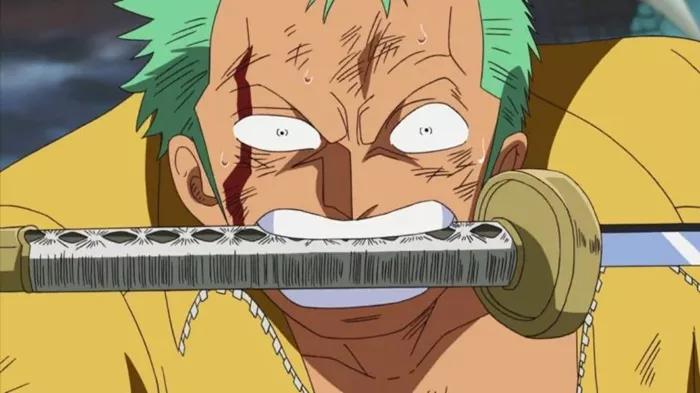In the vast world of anime and manga, few characters are as enigmatic and intriguing as Roronoa Zoro from the popular series “One Piece.” Known for his incredible swordsmanship and unwavering dedication to his captain, Monkey D. Luffy, Zoro is a fan favorite among viewers. However, one particular scene in the series has left fans puzzled and curious: the moment when Zoro deliberately cuts himself. In this comprehensive analysis, we delve into the context, symbolism, and possible interpretations behind this perplexing act.
The Scene in Question
The scene in question occurs during the “Thriller Bark” arc of “One Piece,” specifically in Chapter 485 of the manga and Episode 377 of the anime. In this arc, the Straw Hat Pirates find themselves on Thriller Bark, a massive ship controlled by the infamous Warlord of the Sea, Gecko Moria. As the crew faces off against various adversaries, Zoro encounters a mysterious swordsman named Dracule Mihawk, known as the greatest swordsman in the world.
During their battle, Zoro makes a bold declaration: he vows to never lose again until he defeats Mihawk and becomes the world’s greatest swordsman himself. To solidify his resolve, Zoro performs a dramatic and seemingly reckless act. He takes one of his swords, a cursed blade named Sandai Kitetsu, and slashes his own chest, leaving a deep gash and drawing blood.
Symbolism and Interpretations
Zoro’s decision to cut himself is laden with symbolism and significance, sparking various interpretations among fans. Here are some of the possible explanations for this dramatic gesture:
1. A Pledge of Dedication
One interpretation of Zoro’s self-inflicted wound is that it serves as a physical manifestation of his unwavering dedication and determination. By cutting himself, Zoro symbolically demonstrates his commitment to his goal of surpassing Mihawk and becoming the world’s greatest swordsman. This act underscores his unyielding resolve and willingness to endure any hardship or sacrifice to achieve his aspirations.
2. Embracing Pain and Growth
In the world of “One Piece,” strength is often intertwined with the ability to endure pain and overcome adversity. Zoro’s decision to cut himself may symbolize his willingness to embrace pain as a catalyst for growth and improvement. By confronting his own mortality and demonstrating his fearlessness in the face of danger, Zoro reaffirms his resolve to push himself beyond his limits and evolve as a swordsman.
See Also: how old is zoro
3. Rejecting Weakness and Doubt
Throughout the series, Zoro is portrayed as a stoic and fiercely independent individual who values strength and self-reliance. By cutting himself, Zoro may be symbolically rejecting any perceived weakness or doubt within himself. This act serves as a declaration of his confidence in his abilities and his refusal to succumb to fear or hesitation, even in the face of formidable opponents like Mihawk.
4. Embracing the Path of the Swordsman
In Japanese culture, the path of the swordsman, or “bushido,” is often associated with discipline, honor, and self-sacrifice. Zoro’s decision to cut himself may reflect his embrace of this ethos and his willingness to adhere to the code of the samurai, even at great personal cost. By demonstrating his willingness to shed his own blood in pursuit of his goals, Zoro reaffirms his commitment to the way of the sword.
5. Foreshadowing and Character Development
From a narrative perspective, Zoro’s self-inflicted wound may serve as a moment of foreshadowing and character development. It sets the stage for his ongoing journey to become stronger and overcome increasingly formidable challenges. This act of self-mutilation marks a pivotal moment in Zoro’s character arc, signaling his transformation from a talented swordsman to a true master of his craft.
Impact on the Story
Zoro’s decision to cut himself leaves a lasting impression on both the characters within the story and the audience. It serves as a defining moment in his character development, highlighting his determination, courage, and unwavering resolve. The significance of this act reverberates throughout the series, shaping Zoro’s interactions with other characters and influencing his decisions and actions moving forward.
Furthermore, Zoro’s willingness to inflict harm upon himself underscores the high stakes of the challenges he faces and the intense rivalry between him and Mihawk. Their battle becomes not only a physical contest of strength and skill but also a symbolic clash of ideologies and aspirations.
Conclusion
In the world of “One Piece,” Roronoa Zoro’s decision to cut himself during his battle with Dracule Mihawk is a moment of profound significance and symbolism. While the exact interpretation of this act may vary among fans, it is clear that it serves as a testament to Zoro’s unwavering dedication, determination, and courage. By confronting his own mortality and embracing the path of the swordsman, Zoro reaffirms his commitment to his goals and sets the stage for his ongoing journey of self-discovery and growth. As one of the most iconic moments in the series, Zoro’s self-inflicted wound continues to captivate and intrigue audiences, sparking discussions and interpretations that delve deep into the heart of his character and the themes of “One Piece” as a whole.

